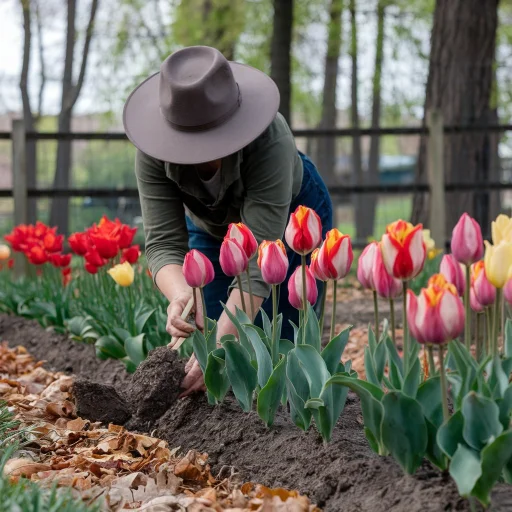Visit our online store for 100% handmade items!

Nothing chases the winter blues away quite like the emergence of beautiful pops of colour in the spring. Spring comes alive from tulips, daffodils, crocuses, snowdrops, hyacinths, and alliums. When the world is just awakening from its long winter’s nap, these beautiful flowers signal a sign of hope. They are also a sign of new beginnings as we transition into the spring gardening season.
Did you know, fall is actually when you plant many of the bulbs that produce springtime blooms? In the fall, many garden centres are bursting at the seams with tons of varieties of fall bulbs to plant in your garden. If you’re feeling overwhelmed and wondering what to choose and when to plant, you’ve come to the right place. The tips in today’s blog will put you on the right path to creating beautiful springtime showcases of flowers in your own garden.

What’s the difference between fall and summer bulbs?
Fall bulbs are different from summer bulbs that you would plant such as dahlias, gladiolus, canna lilies etc. Instead of being planted in spring for summertime blooms, flowers like tulips and daffodils are planted in the fall. Fall planted bulbs need a period of colder weather so that they can begin to set down viable roots.
Not only do fall planted bulbs produce a stunning springtime display, but they also add many benefits to your garden landscape. When the pollinators awaken from their winter slumber, many of these flowers are the first that they will visit in your garden.
Attracting pollinators to your garden is vitally important when it comes to preparing for your summer gardens. This is especially true if you are growing your own fruits and vegetables. Pollinators help to pollinate your crops and produce a bountiful harvest. So, when you stop to admire the displays of fall bulbs at your local store this season, grab a bag and get started planning your spring garden!
When is the best time to plant fall bulbs to produce springtime flowers?
Aim to get your fall bulbs planted about six weeks before your first hard frost. For those gardening in more Northern climates , aim for around the end of October or Halloween. For more southern-based gardeners, aim for October or November to plant your fall bulbs.
Remember to always check your local forecast and know your frost dates. Timing the planting of fall bulbs is always dependent on current weather conditions.
If you are growing in a very southerly climate, you may need to pre-chill your bulbs before planting. Also, some fall bulbs may only produce for one year. If you are planting in a more southerly growing zone, be sure to check if the bulbs you are purchasing have already been pre-chilled. Also check to see whether or not they will be an annual in your area or a perennial.
What should I look for when selecting fall bulbs to plant in my garden?
Make sure that when you are examining the bulbs that they appear fresh, firm, and do not break apart when you press on them with your hand. Steer clear of any bulbs that fall apart when you handle them. Avoid bulbs that appear moldy or that seem shriveled up and dried out. Bulbs that look this way could be old and less viable. There is nothing worse than going to all the work to plant your bulbs in the fall only to be disappointed when nothing produces from them next spring.
Another important thing to look out for is bulbs that have a papery husk on the outside. This papery husk helps keep the bulb fresh and free from diseases. These husks should be intact when purchasing fall bulbs.
If you can’t plant your bulbs right away, be sure to keep your bulbs in a cool, dry, and dark place until you are ready to plant. If they are stored in a place that is too warm or moist, it risks interrupting the blooming cycle for the spring.
Choosing the best location to plant your bulbs and preparing the beds
Choose a spot in your garden that gets at least 6 hours of sunlight. Some bulbs like daffodils can be planted around a tree because they bloom so early in the year.
Make sure that the area has a good blend of organic matter and that it is well draining. If bulbs are left in soil that is soggy or are overwatered, there is a risk that they could rot. Also make sure that the area is free of weeds, old plant matter, and that the soil is loose and worked through.

How to plant your bulbs
A good rule of thumb to remember is to plant the bulbs roughly two to three times deep for however tall the bulb is. You can eyeball this, and once you have planted a few, you will get the hang of it. Also, always remember to plant your bulbs with the pointy end up. This way they will be in the right position when it comes time to bloom in spring.
Final thoughts on planting fall bulbs
Planting fall bulbs is often one of the last outdoor gardening tasks before winter takes hold in many gardens. It often comes around the same time as planting garlic.
Until next time gardening friends, try planting some fall bulbs in your own garden this season. With so many colours, shapes and textures to choose from, there is sure to be something out there that catches your eye! And for more helpful tips and tricks, be sure to follow us on Facebook, Instagram, and Pinterest. Or, subscribe to our monthly newsletter.



